Thursday 13 October 2016
White: A. Fletcher (74) - Black: K. Nevols (134)
1. e4 d5
Having got a good position in my last game as Black, I decided to give this defence another go.
2. exd5 Qxd5
3. Nc3 Qa5
4. d4 Nf6
5. Bd2 c6
This is my standard response to an early Bd2 but maybe there is nothing to fear from the discovered attach and Black should get on with development with Bf5.
6. Nf3 Bf5
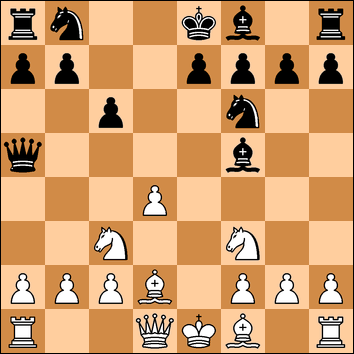
Now 7. Qe2!? is an interesting pawn sacrifice although Black can get away with 7. .. Bxc2. However 7. Bc4 e6 8. Qe2!? is much stronger when 8. .. Bxc2 9. d5! and already Black is struggling to stay on the board. 8. ... Qc7 would be a safer option.
7. Be2
Instead of the usual 7. Bc4 White aims for a more quiet development.
7. ... e6
8. a3 Qc7
With the kings' bishop limited, it is now time to redeploy the queen and pre-empt a White Bf4.
9. Nh4 Bg6
10. Nxg6 hxg6
11. h3 Nbd7
12. Bd3 Bd6
Both sides continue on their development.
13. Qf3!?
A fascinating move. White offers a pawn sacrifice, places the queen on an aggressive spot, and intends to develop an attack.
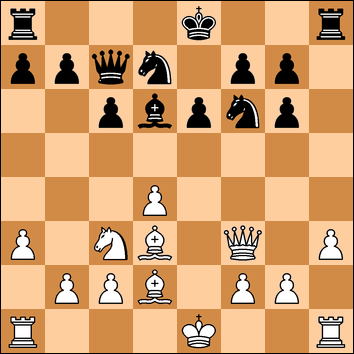
13. .... Qb6
14. O-O-O
Now the question is - should Black take that pawn on d4? My instinct told me no. After 14. .. Qxd4 15. Be3, the queen is running short of squares, White has pieces in the centre, and my king is not yet castled. But 15. .. Qe5 is simple enough and then finding a haven on either a5 or h5. (16. Rhe1 Qa5 17. Bd4 O-O-O 18. Ne4 Be7 should be able to hold).
14. .... Nd5
But I decide not to take any risks.
15. Nxd5 cxd5
16. c3
My first thought was that this was a mistake but in fact, in the absence of Black's white squared bishop, it is a sensible move to secure the queenside.
Now I want to castle queenside but the f7 pawn would be loose so my own thoughts turned to tidying up.
16. .... Qc7
17. Rde1 O-O?
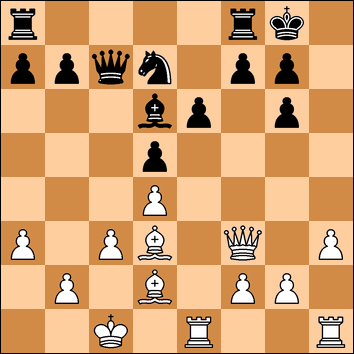
After the game I was kicking myself for this move. When White has a queen on f3, bishops pointing towards the kingside, and a rook on h1 ready to push a pawn to create havoc, the one thing Black should not do is castle right into it. I told myself I should have played 17. ... Nf6 (18. Bg5 Be7 19. Bf4 might be tricky) or 17. .... Nb6 (the point of Qc7 and preparing to castle queenside, although White could whip up an attack with 18. a4!?).
The computer however simply states that castling kingside is Black's best move. It does not worry about havoc.
18. h4!
Oh dear! Now I knew I was in trouble. The pawn is going to come to h5, the queen over to the h-file, and I would be mated or lose material. I sank into deep thought to put together a defence.
18. ... Nf6
Adding a piece in front of the king cannot be bad but Black could have tried 18. .. Qc6, the point being to answer 19. h5 with 19. ... e5!?.
If 20. hxg6 fxg6 21. Qh3 then 21. ... e4. 22. Qh7+ Kf7 23. Bc2 Nf6 or 23. Be2 Kf7. If 20. dxe5 Nxe5 21. Qe2 Nxd3 22. Qxd3 Bc5! (a lateral defence of the g6 pawn) 23. hxg6 fxg6 24. Qh3 Rae8! planning to exchange off one rook and weaken the attack.
An immediate 20. Qh3 might be stronger with 20. .. e4 21. Be2 and then it depends if Black can find 21. ... Rfe8! because otherwise the pawn move to h6 threatens the end. (22. h6 Bf8).
I didn't see 18. .. Qc6 and thought I would try to hold up the h5 move.
19. h5!
But without success. Now I saw 19. .. Nxh5 20. Rxh5 gxh5 21. Qxh5 g6 22. Bxg6 fxg6 23. Qxg6+ Qg7 24. Qxe6+ Rf7 25. Qxd6 (but did not go one move further to 25. .. Qxg2). White is the exchange down for two pawns and Black's king is in the open. A difficult ending.
Another line is 19. .. Nxh5 20. Rxh5 gxh5 21. Qxh5 f5 22. Rxe6 where White has a pawn for the exchange and is about to round up the second. Here one defence is 22. .. Bf4 23. g3 Qf7! forcing the queens off. After 24. Qxf7 Kxf7 25. Bxf5 Bxd2+ (better is the immediate 25. .. Rae8 forcing 26. Rxe8 Bxd2+) 26. Kxd2 Rae8 another difficult task awaits Black. White will try to round up the loose pawn on d5.
So having ruled out 19. .. Nxh5 I grimly had another long think. By now, we were both running low on time.
In the end I decided to sacrifice a pawn to gain time to set up a defence..
19. .... g5?!
The point is that after 20. Bxg5 Nh7, the h-file stays blocked and I can answer a future h6 with g6. All the same Black's best move would be to take the pawn. After 21. Bd2 I still needed to think of what to do next and White could think about advancing the g-pawn.
20. h6
White decides to push on nonetheless.
20. .... g4
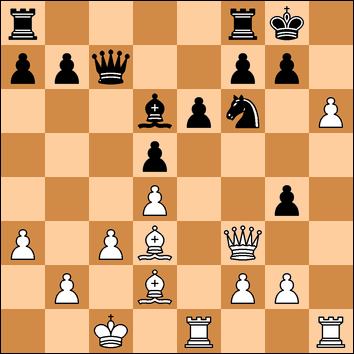
This was another point to the g5 move. This gets a tempo against the queen and stops it getting to the h-file. 20. ... Bf4 is another option might forcing some exchanges. After 21. Bxf4 Qxf4+ 22. Qxf4 gxf4 23. hxg7 Kxg7 24. Rf4 White will be a pawn up.
Now as I went off to get another drink, I pondered what to do after 21. Qe3 g6 22. Qg5. Playing 22. .. Qe7 23. Bxg6! did not look like a lot of fun and so I decided to grovel with 22. .. Nh7 23. Qxg4. I would be a pawn down but still on the board. What to do next? No idea. That was my next problem.
(The computer suggests 23. .. Rac8 daring White to try 24. Bxg6 fxg6 25. Qxg6+ Kh8 and then either 26. Rxe6 Rxf2 or 26. f3 Rf6. If not, Black could play Rfe8, move the queen about and see what White intends. Maybe Black has a chance of counterplay with a plan based around e5).
White could also try 21. h7+ Kh8 22. Qe3 but I could not see any immediate problem with that, and I glanced at 21. Bh7+ and saw that was nothing.
As I came back to the board, I could see to my surprise a white bishop nearly in the corner.
21. Bh7+??
Doesn't this just lose a piece? And an attacking piece too? What am I missing? I decided to find out.
21. ... Nxh7
22. Qxg4 g6
Well, this looked fine to me now. I decided if I could force some exchanges, I could use the extra piece and round up the pawn. To my additional surprise, it is White who goes for exchanges.
23. Qf3 Qd8
24. Bf4 Bxf4
25. Qxf4 Qf6
26. Qxf6 Nxf6
27. Re3 Kh7
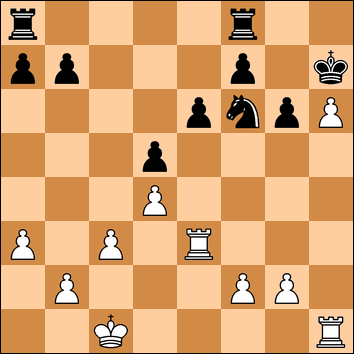
Now everything is covered. Ng4 taking on h6 and walking into Reh3 would not be very clever. So instead I decide to advance the kingside pawns and take the h-pawn with the rook. And then my extra piece should decide.
28. Rf3 Ne4
29. Rf4 g5
30. Rf3 f5
31. Re3 Rf6
32. Re2 Re8
33. f3
The final mistake but White is now lost anyway.
33. ... Ng3
White now resigned and I breathed a sigh of relief. My opponent said he was surprised that I castled kingside and indeed I should have not have done so as up to then I thought I was in control.
I went back to the position after 20. .. g4 and then played 21. Qe3 and tried all sorts of defences - all of which led to a very unpleasant position but not a clear win.
No comments:
Post a Comment